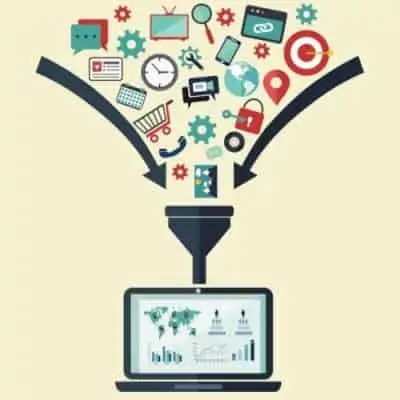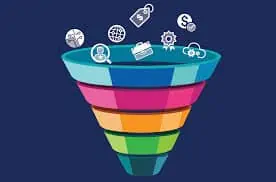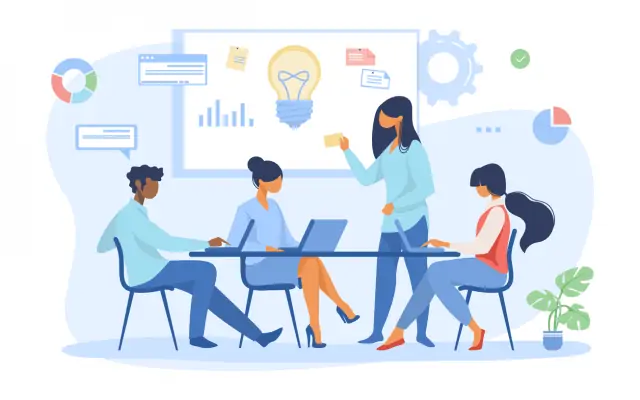
Marketing funnels are an expert marketing strategy that entails using different marketing tactics depending on where a person is in their buyer’s journey. Each customer goes through specific steps before finally making a purchase. Can think of these steps as a path a consumer moves to become a customer.
When marketers target people at different stages with different tactics to send them further along the path, they use a marketing funnel.
It calls a funnel because you lose customers as you move along the stages. If you start with 100 customers at the top of the funnel, only a tiny share of these will finally make it to the last step and make a purchase. Therefore, the number of people keeps decreasing with each stage, and that’s why it is called a funnel.
Stages of a Marketing Funnel
Most marketers categorize the stages of a marketing funnel based on the popular 4-stage AIDA model. This model follows a customer’s journey from the first point of interaction to conversion.
However, customized marketing funnels and stages can be clubbed or further broken down as needed. Some marketers use a three-step funnel with lead generation, nurturing, and conversion as the three stages. After the conversion stage, some add additional stages like customer retention and remarketing.
However, AIDA remains the most popular and commonly-followed model, so let’s look at the four stages of an AIDA marketing funnel.
Awareness
At this stage, the main goal is to introduce your brand and products to your intended audience. This is the funnel stage where all of your marketing efforts should focus on attracting attention and reaching out to as many people as possible.
Spreading brand awareness and attracting audience attention defines this marketing funnel stage. And the success at this stage pertains to the number of leads you can direct down the tunnel to the next stage.
Interest
This is when people start to develop an interest in your brand or products. They consider your product and those of other brands and start learning about their features and benefits.
From a marketing perspective, your goal at this stage should be to inform them about your product’s features, benefits, and how it is better than other products. This will help make your product more attractive to them.
If you have a service company, your goal would be to convey how your brand differs from others and is a better fit for the prospective customer.
Desire
This is the stage in a buyer’s journey where they start wanting your product or service and have a high purchase intent. This stage essentially marks the change from “I like it” to “I want it” from a customer’s perspective.
From a marketing perspective, this is the stage where you need to ensure that you provide that nudge and convert these high-intent leads into customers. You need to interact with your prospective customers to increase the desirability of your product.
Also, more often than not, the Interest and Desire stages go hand-in-hand and happen almost simultaneously or in close succession. Therefore, these two stages can be combined to make one lead nurturing stage. The key goals here are to engage consumers and make them want your product over others.
Action
This is the final stage of a marketing funnel, during which the consumer takes the desired action and converts into a customer. Any marketing materials targeted at customers at the bottom of the funnel should convey a sense of urgency to take action.
Why You Should Have a Marketing Funnel

Marketing funnels help provide a structure to all your marketing activities and tell you how to target a customer in the best way. Marketing is much more effective when you target prospects based on which funnel stage they are in.
People at the top of the funnel are not even aware of your brand yet, so you can’t simply expect them to make a purchase; you need to inform them first. Sending a bottom-of-the-funnel prospect marketing material to spread brand awareness is equally futile.
The best way to target consumers is to know where they are in the marketing funnel and use the right marketing tactics to direct them further down the tunnel.
The Benefits of Marketing Funnels
Marketing funnels simplify the customer journey and make it easier for companies to follow. These solutions map out each stage of their client’s decision process and plan the steps they want to take in each.
A marketing funnel applies to almost any customer interaction. It would be best to have a marketing funnel, whether you’re looking for online sales, generating traffic for your brick-and-mortar store, or collecting clicks as an affiliate. The horn is a powerful way to bring visibility to every stage of connecting with your customer.
The biggest benefit of marketing funnels is their measurability. Your funnel shows you where you’re losing customers to help you pivot your strategy. For instance, if you lose customers before they ever get to the second stage, you need a better brand awareness campaign.
Marketing Strategies for Each Stage of the Funnel

This section will discuss the various marketing techniques that you can use at each stage of the marketing funnel. As the Interest and Desire stages go hand-in-hand and usually require similar marketing tactics, we have clubbed them together.
Lead Generation Strategies (Awareness Stage)
As mentioned earlier, the marketing activities at this stage aim to spread brand awareness. As this is the top of the funnel, the more people you can reach and direct down the tunnel, the better. Therefore, the focus here is on the quantity and not the quality of leads.
Here are some top-of-the-funnel marketing tactics that can help you reach many people.
Influencer Marketing
If your goal is to reach as many people as possible, there’s no better way than using popular influencers to introduce your brand to consumers. Influencers usually have large and engaged follower bases that you can reach by collaborating with them.
Take this social media post, for example. A simple brand mention from a valid Instagram account can help put a brand on the map. The influencer, in this case, is a cat owner. A simple brand mention helped the cat food brand reach over 89k people.
Organic SEO
Another helpful strategy at this funnel stage is to optimize your website content for keywords to improve your organic search rankings. Many leads come to a website via this channel, so it is essential to optimize it.
Advertising
PPC ad campaigns are one of the most common top-of-the-funnel marketing strategies used to generate leads if you have a big budget. These ads show many relevant people who enter search queries related to your niche. So, using PPC ads, you can generate quality leads.
If there’s ever a need for good content to engage your audience, it is at this funnel stage. People who have just been introduced to your brand and are ready to explore more are best targeted with relevant and engaging content. Therefore, content marketing is an effective mid-funnel marketing strategy.
Here is a list of the different types of content that work well for each marketing funnel stage. As a rule, case studies, whitepapers, and other informative content target middle-of-the-funnel buyers.
Reviews
Using product reviews is another effective strategy to get people interested in your products and direct them further down the funnel.
You can use customer reviews and showcase them on your website. You can also get influencers to write detailed product reviews and share them with their audiences. These will help alleviate any concerns people have before buying your product and make them want it more.
Lead Conversion Strategies (Action Stage)
This is when you need to convince prospective buyers to take action and make a purchase. Therefore, all marketing strategies at this stage focus on creating a sense of urgency and making it easy for people to complete the purchase.
Here are some of the most effective lead conversion strategies that you can use:
CROP
Conversion rate optimization (CRO) strategies enable people to convert with ease. These usually include website optimization and adding the right calls-to-action (CTAs) to make it easier for people to take the desired action.
Including CTAs like “Buy now” or “try it now,” etc., provide these high-purchase-intent users with an easy way to make a purchase. These CTAs direct people from anywhere on your website to the purchase pages.
Demos and Trials
Providing a free trial or a live demo improves a prospect’s chances of making a purchase. These strategies are beneficial for SaaS and other services companies.
A demo can help consumers understand the product better and see the user interface. This aids the decision-making process, especially in the case of complex software and tools.
Similarly, a free trial encourages people to try your product or service before investing their money. A good experience with the prosecution usually translates into a purchase later.
Discounts and Promotions
Similar to how service companies use trials and demos, product-based companies can use promotional strategies to encourage people to make a purchase. A limited-time discount, coupon, or any other offer creates a sense of urgency and helps speed up the purchase process.
Conclusion
Now you know what a marketing funnel is and what strategies you can use at each stage to best target your prospective customers. However, a marketer’s job does not end with a customer making a purchase. It would help if you had a clear customer retention strategy to ensure that these hard-earned customers stay with your brand for a long time.
When you design a marketing funnel for your brand, don’t forget to add an extra stage at the end, focused on retaining your customers. This strategy can go a long way to keep your business profitable. So, go ahead and start working on your marketing funnel now.
Private Agent for Dropshipping Success